
Military History - Operation Urgent Fury, Grenada, 25-29th October, 1983
BACKGROUND
In the early-mid 1980s the world was held in the vice-like grip of the Cold War. The two factions, NATO and WARPAC contested the border of split Germany. Communist uprisings and rebellions grew like wildfire in South-East Asia, while the CIA backed coups throughout Central and South America. The dual threats of conventional and nuclear war were never far away.
The man in the White House at this time was President Ronald Reagan. A previous Hollywood Celebrity, Reagan has left mixed views about his presidency, though the Operation Urgent Fury remains one of the most controversial.
The small Island nation of Grenada is located some 160 kilometres (99 miles) North West of Venezuela.
Measuring approximately 348 km squared, it housed a population of around 91,000. Located in the Lesser Antilles; Grenada gained independence from the United Kingdom in 1974 under the leadership of Sir Eric Gairy. Head of the Grenada United Labour Party, Gairy claimed victory in the general election of 1976 - a claim disputed by his political rivals - with ongoing civil strife turning to street violence in the wake of the election, the two main opposing forces were Gairy's personal army, the 'Mongoose Gang' and gangs organised by the New Joint Endeavor for Welfare, Education, and Liberation, or New JEWEL Movement (NJM). The NJM were a Marxist-Leninist headed by Maurice Bishop. In the late 1970s, the NJM began to plan a coup aimed at overthrowing Gairy and the United Labor Party - some members of the NJM were trained by military forces overseas, allegedly in camps located in Cuba.
On the 13th March 1979, Gairy was away from Grenada. Using his absence as an opportunity, the NJM launched an armed coup and seized control of Grenada. Under Maurice Bishop, the new People's Revolutionary Government was created.
During the next few years, Bishop strengthened his ties with other Communistic states worldwide, most notably with the Cuban Government, though in 1982 he was photographed meeting with Unison Whiteman, the DDR's (Soviet East Germany) Foreign Minister.
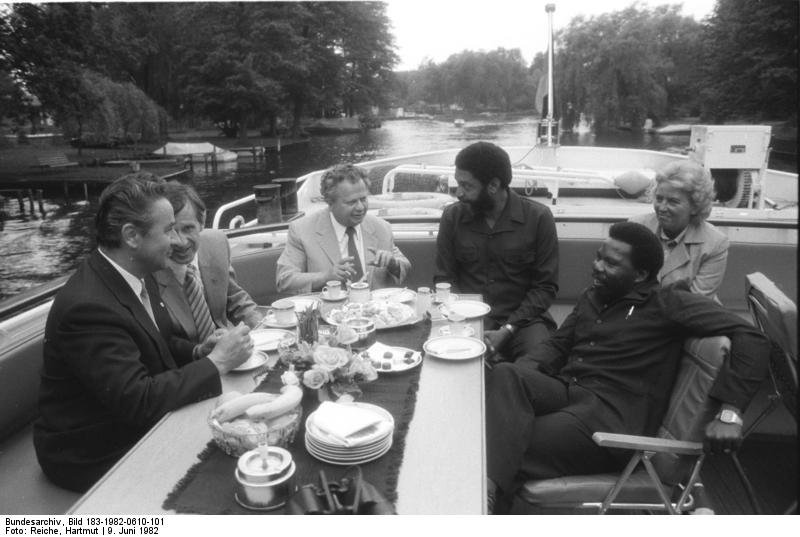
During this time, the People's Revolutionary Government began constructing a new airfield, supposedly with the aims of accommodating civilian airliners. The new airport, Point Salines International Airport, was constructed in the South of the country, as the Northern airstrip, Pearl's Airstrip, was located in such a way that expansion of it's runways were not possible.
The American Central Intelligence Agency (CIA) was convinced that this new runway was being built to support a Soviet-Cuban military buildup in the Caribbean. The new 9,000 foot runway was capable of accommodating the largest planes the Soviet Air Force had to offer - and the CIA's belief was that this airport would be used to transport arms and equipment from Cuba and beyond throughout Central America. This belief was echoed throughout the Pentagon, and inside the Oval Office.
In 1983, Ron Dellums - a member of the US House of Representatives, travelled to Grenada on a fact finding mission. Upon his return he spoke of his findings on Grenada in front of Congress.
Quote... based on my personal observations, discussion and analysis of the new international airport under construction in Grenada, it is my conclusion that this project is specifically now and has always been for the purpose of economic development and is not for military use. ... It is my thought that it is absurd, patronising, and totally unwarranted for the United States government to charge that this airport poses a military threat to the United States' national security.
President Reagan remained unswayed. In March of 1983, he issued warnings, stating that the Caribbean and the United States itself were being threatened by "Soviet-Cuban militarisation", directly referencing the new airport on Grenada. In his speeches, Reagan stated that the new runway was far longer than needed for commercial flights, and possessed numerals fuel storage tanks - more than would be expected in any civilian airport - his theory being that the airport was to be turned into a forward Air Base for the Soviet Air Force.
On 16th October, 1983, an internal faction of the People's Revolutionary Government, led by Deputy Prime Minister Bernard Coard seized power. Bishop was remanded and placed under house arrest. During mass demonstrations against Bishop's treatment, Bishop found himself with a chance to escape. He reasserted himself as the head of the Government, operating in secret. Bishop was, however, captured and along with his pregnant wife, executed. The Government killed several union leaders who were loyal to him as well.
After Bishop's murder, Hudson Austin created a military council to rule the country. Austin ordered the capture and imprisonment of the Governor General Paul Scoon. Scoon was placed under house arrest in his Mansion in Saint George.
Following these revelations, the Organisation of Eastern Caribbean States (OECS), Barbados and Jamaica appealed to the United States for assistance.
The US responded, with Operation Urgent Fury on the 25th October, 1983; stating that it the intervention came at the request of the Prime Ministers of Barbados and Dominica. The United Nations General Assembly condemned the action as "a flagrant violation of international law".
THE PLAN
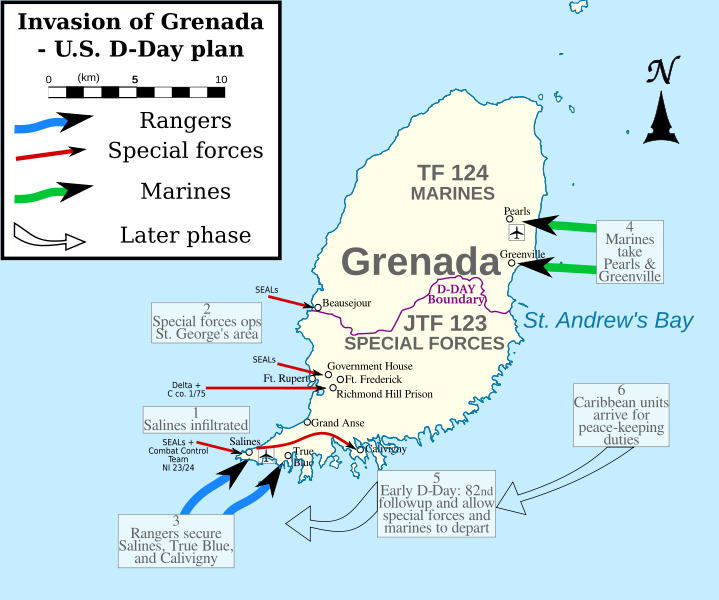
The D-Day plan for Operation Urgent Fury was 6 fold.
- The city of Salines was to be infiltrated by SEALs and a Combat Control Team
- SEALs, Delta Force and the 75th Rangers operate around St George & Fort Rupert
- Port Salines International Airport to be captured by 75th Rangers. They would then assault and secure True Blue and Clivigny - True Blue had a number of American Students trapped inside.
- US Marines would assault Pearls Airstrip and Greenville
- The 82nd Airborne occupy Pearls & Salines, allowing the Marines and Special Forces to conduct further operations
- Caribbean Peace Keeping forces arrive to occupy cities and towns throughout secured areas
To complete the operation, the United States activated some 7,300 men. The Task Force was comprised of the following units :
US Ground Forces :
- 1st & 2nd Ranger Battalions, 75th Ranger Regiment
- 2nd Brigade (325th Regiment), 3rd Brigade (1/2 Bn, 505th Parachute Infantry Regiment) & Supporting units of the 82nd Airborne Division
- Company E (Scout), 60th Infantry Regiment
- 27th Engineer Battalion
- 548th Engineer Battalion
- 160th Aviation Battalion
- 18th Aviation Company, 269th Aviation Battalion
- 1st/2nd Company, 82nd Combat Aviation Battalion
- 1st Squadron, 17th Air Cavalry Airborne
- US Navy SEAL Teams 4 & 6
- 22nd Marine Amphibious Unit
- Numerous supporting units (65th/118th/503rd/411th MP Battalions, 35th/50th Signal Brigades, 319th/519th Military Intelligence Battalions, 9th Psychological Operations Battalion, 1st Corps Support Command [COSCOM], 44th Medical Brigade including 5th MASH, 82nd Finance Company, 507th Tactical Air Control Wing [TACPs], 21st Tactical Support Squadron [FACs] & 24th Special Tactics Squadron Det 1 MACOS Combat Controllers)
US AIR FORCE
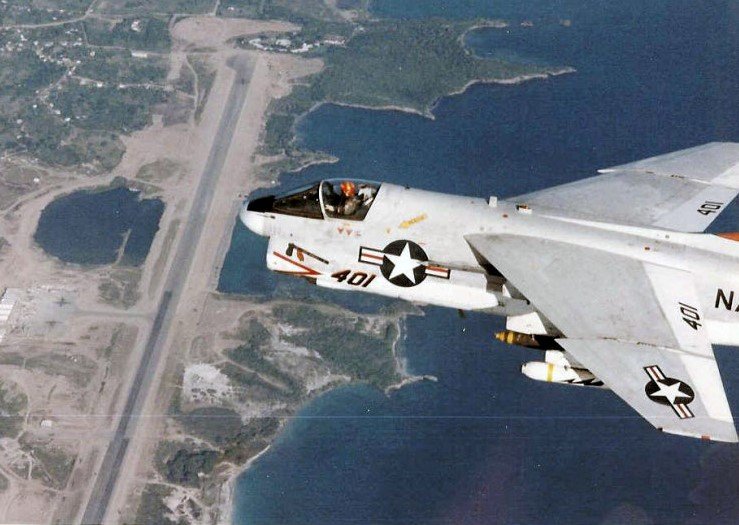
- Various Air National Guard Wings - flying A-7D Corsair II for CAS
- 23rd Tactical Fighter Wing - flying A-10 Warthogs
- 26th Air Defence Wing NORAD - flying F-15 Eagles
- 33rd Tactical Fighter Wing - flying F-15 Eagles
- 437th Military Airlift Wing - flying C-141 Starlifters
- 16th Special Operations Wing - flying AC-130H Spectre Gunships
- 552nd Air Control Wing - flying E-3 Sentry AWACS
- 62nd Security Police Group - providing security and prisoner detention
- 60th Security Police Squadron - providing security
- Numerous support flights (136th Tactical Airlift Wing - C130s, 437th Military Airlift Wing - C-141s, 317th Military Airlift Wing - C-130s, 63rd Military Airlift Wing - C-141s, 19th Air Refuelling Wing)
US NAVY
Two formations of US Warships were present for Urgent Fury. The USS Independence (CVA-62) Carrier Battle Group & the Marine Amphibious Readiness Group. Following is a list of naval forces deployed.
_at_sea_during_the_later_1980s_or_early_1990s_(NH_97715).jpg.1d8fa480670a9dc7723021265d1495e1.jpg)
USS Independence
Independence Carrier Group (CVA-62)
- USS Independence - Forrestal-class Supercarrier
- USS Coontz - Farragut-class Frigate
- USS Moosbrugger - Spruance-class Destroyer
- USS Caron - Spruance-class Destroyer
- USS Clifton Sprague - Oliver Hazard Perry-class Missile Frigate
- USS Suribachi - Suribachi-class Ammunition Ship
-
Squadrons Aboard USS Independence :
- Fighter Squadron 14 - 13 F-14A Tomcat
- Fighter Squadron 32 - 14 F-14As
- Attack Squadron 176 - 16 A-6E Intruder
- Attack Squadron 87 - 12 A-7Es
- Attack Squadron 15 - 12 A-7Es
- Carrier Airborne Early Warning Squadron 122 - 4 E-2C Hawkeye
- Electronic Attack Squadron 131 - 4 EA-6B Prowler
- Helicopter Anti Submarine Squadron - 6 SH-3H Sea King
- Sea Control Squadron 28 - 1- S-3A Viking
Amphibious Readiness Group
- USS Guam - Iwo Jima-class Assault Ship
- USS Barnstable Country - Newport-class Tank Landing Ship
- USS Manitowoc - Newport-class Tank Landing Ship
- USS Fort Snelling - Thomaston-class Dock Landing Ship
- USS Trenton - Austin-class Amphibious Transport Dock
In all, the United States created a Task Force of overwhelming power. Official statements vary as to the amount of aircraft in operation during Urgent Fury, as many squadrons flew over the assigned combat area without taking part in strikes, yet they are recorded as having participated. Conservative estimates say that the US Ground Forces had at least 200 fixed-wing aircraft on call to assist them.
Urgent Fury also saw the first deployment of UH-61 Black Hawk helicopters in a combat setting.
All of this force was brought to bare against a hostile force woefully outnumbered against the US. Grenada fielded some 1,200 soldiers. They had a handful of BRDM-2s and BTR 60s, some ZU 23 anti-aircraft guns. There was no confirmed number of these weapons, or even of the number of infantry Grenada could muster - although some reports state Grenada had 8 BTRs and 2 BRDMs. There were however, confirmed numbers of advisers/volunteers from other nations.
- Grenada - c. 1200 soldiers
- Cuba - 780 Paramilitaries
- Soviet Union - 49 Military Advisers
- North Korea - 24 Personnel
- East Germany - 16 Advisers
- Bulgaria - 14 Advisers
- Libya - 3 or 4 Advisers
Intelligence had led the US forces to believe that Grenada could muster upwards of 2000 armed soldiers - believing that Cuba had sent hundreds of professional trained and dedicated men. This view was, however, blurred. Of the estimated 780 Cuban nationals on the island, 636 were formally listed as construction workers. This didn't mean they were not combatants however, as many Cuban 'workers' were in fact armed. Fidel Castro said of the Cubans that they were "workers and soldiers at the same time."
Despite outnumbered and out gunned, and with no recorded Air Force, the Grenadians fought back during Urgent Fury.
D-DAY 25TH OCTOBER
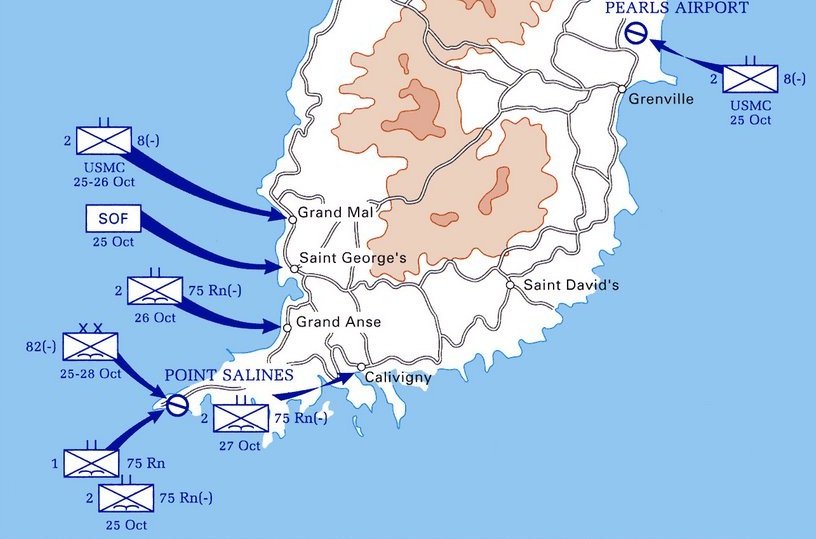
Prior to combat operations commencing, SEAL Team 6 and attached Air Force Controllers were dropped at sea to conduct reconnaissance on Point Salines. However, when a storm blew in rapidly 4 of the SEALs drowned. Machinist Mate 1st Class Kennith J Butcher, Quartermaster 1st Class Kevin E Lundberg, Hull Technician 1st Class Stephen L Morris and Senior Chief Engineman Robert R Schamberger were never recovered. The mission was cancelled and the remaining members recovered. Another operations was attempted, but also cancelled due to harsh weather.
Meanwhile, SEAL Team 4 landed at the beach near Pearl's Airport to conduct another reconnaissance. They found that the beach was undefended, but not suitable for a naval landing. The decision was made for the Marines to Air-Assault Pearl Airport.
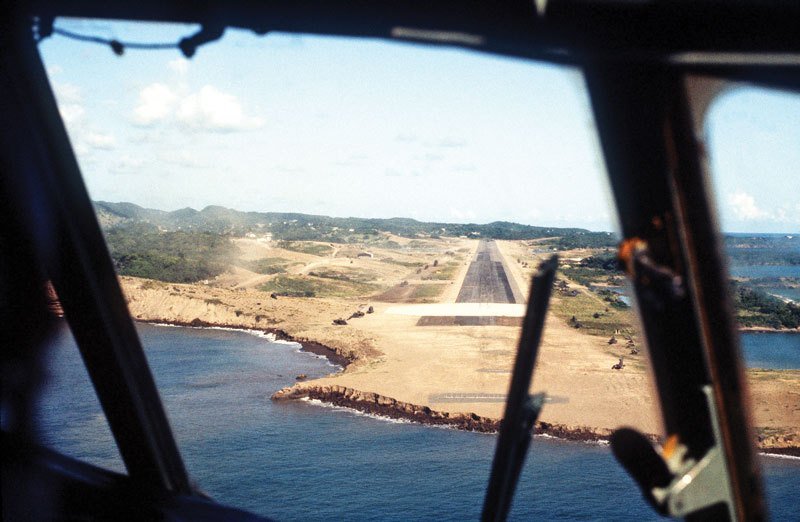
Point Salines International Airport, seen from the cockpit of a C-130
At midnight on the 24th, A & B Companies, 1st Battalion of the 75th Rangers departed Hunter Army Airfield on C-130s. Thy were to conduct an early morning raid on Point Salines Airport. The plan was for the C-130s to land on the runway, with the Rangers disembarking and taking over the airport before the Grenada military could respond.
Last minute recon flights revealed that ZU-23 AA guns were active at the Airport, forcing the Rangers to switch to a paradrop onto the runway instead. At 05:30 on the 25th, A & B Companies jumped onto the Airport, facing resistance from infantry, ZU-23s and several BTR-60s. The firefight continued unabated for 4 hours, with the Rangers calling in support from AC-130 gunships to suppress the areas around the Airport. During the fight, the Rangers commandeered construction vehicles to clear the runway and also used them as mobile cover.

By 10:00 the air strip was clear and reinforcements were flown in. M151 Jeeps and the leading members of the Caribbean Peace Force disembarked. The Rangers began preparing the Jeeps for mobile operations while the CPF set up a perimeter guard around the Airport.
Around 14:00, planes carrying the 82nd Airborne commenced landing at Point Salines. During the disembarkation, at 15:30, 3 BTRs of the Grenadian Army Motorized Company counter attacked the Airport. The attack was repulsed with fire from captured recoilless rifles and support from an AC-130 Gunship.
After this assault, now re-equipped and re-organised with M151 Jeeps, the Rangers moved out of the Airport. Speeding throughout the countryside, they quickly secured lots of ground and successfully negotiated the surrender of over 100 Cubans who had garrisoned themselves inside a hangar.
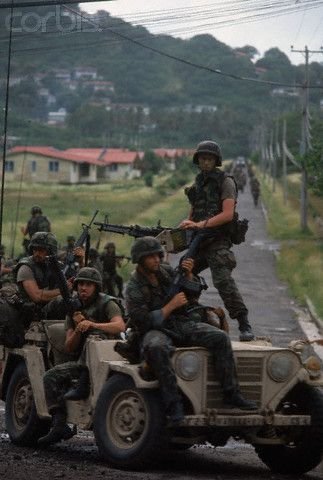
A Jeep mounted patrol was sent to find the True Blue Campus, it's goal to secure and safeguard the American Students there. The patrol got lost however, and ended up being ambushed. After a brief firefight, the patrol suffered 4 killed in action. Later that night, the Rangers made their way to True Blue Campus where they secured and safeguarded 140 Students, only to be told that there were more at another campus in Grande Anse.
While the Rangers were landing at Point Salines, the 2nd Battalion, 8th Marine Regiment landed South of the Airport with CH-64 Sea Knight and CH-53 Sea Stallion Helicopters. The resistance they faced at Pearls Airport was light. Reported as being roughly 'platoon-sized', the local forces pinned lead Marine units down with the use of a DShK Heavy Machine Gun until it was destroyed by a Marine AH-1 Cobra. The remaining resistance diminished rapidly.

Multiple Raids on key locations were conducted throughout the day. Early in the morning of the 25th, the remaining members of SEAL Team 6 were inserted via UH-60 Blackhawk to capture Radio Free Grenada - the plan being to use it for PsyOps purposes. The station itself was captured unopposed, but later during the day a counter-attack by BRDMs forced the SEALs to withdraw into the jungle. They destroyed the transmitter as they left.
Raids were also undertaken against Fort Rupert, the believed location of the Revolutionary Council, and Richmond Hill Prison, where political rivals were being held prisoner. Both raids had members of Delta Force and C Company, 75th Rangers, both using MH-60 Blackhawks and MH-6 Little Birds. The raid on Fort Rupert was a success, with multiple leaders of the People's Revolutionary Government being captured. The Raid on Richmond Hill Prison was not successful however, as the US lacked vital intelligence.
The prison itself was located on a steep hill, with no locations for the Blackhawks to land. There were also multiple ZU-23 AA Guns set up both around and on top of the prison. During the raid, AA fire wounded many passengers and crew members of the Task Force, and caused 1 Blackhawk to crash, trapping some Delta Force operators. Another Blackhawk was diverted to protect the crash site. One pilot died, and another force of Rangers had to be sent to the Prison to support the Delta Operators.
The final major Raid on the 25th was an operation conducted to rescue Governor General Paul Scoon. Still within his mansion in Saint George, an unidentified SEAL Team was flown from Barbados to Grenada. However, the team left late - at 05:30, while major combat operations were already underway.
The SEAL team made no hostile contact during their insertion and entry into Scoon's mansion. However, a large counterattack including BTR-60s trapped the SEALs for several hours. Grenadian forces laid siege to the mansion, forcing the SEALs to call in air support, in the form of AC-130 Gunships, A-7 Corsairs and AH-1 Cobras. The airstrikes prevented local forces from storming the mansion, but the SEALs would remain trapped until members of G Company, 22nd Marine Assault Unit relieved them 24 hours later.
The Forts Frederick and Rupert were targeted by airstrikes by Navy A-7 Corsairs and Marine helicopters. The target for both was AA emplacements, preparation for assault from ground forces. One strike on Fort Frederick missed, instead hitting a mental hospital and killing 18 civilians. A further Raid on Fort Frederick resulted in the loss of 2 Marine AH-1T Cobras and a UH-60 Blackhawk, with 5 KIA.
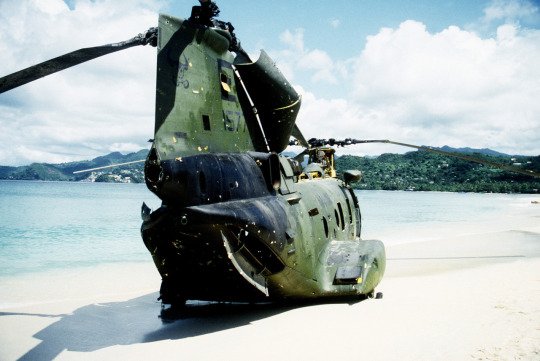
A downed Marine Corps CH-46 on the beaches of Grenada
D+1, 26th OCTOBER
The US had 2 objectives during the 2nd day of Urgent Fury.
- Securing the area around Salines Airport
- Rescuing US students tapped at Grande Anse
The Army units on the ground had suffered losses and damage to their transportation helicopters, and as such the US commander - General Trobaugh - was forced to delay the rescue operation until he had made contact with the Marines.
The majority of Cuban Paramlilitaries were garissoned in a compound near the village of Calliste. They had sent out small patrols and deployed ambush teams throughout the area. Early on the morning of the 26th, a ptarol from the 2nd Battalion, 325th Infantry was ambushed by one of this patrols near Calliste. The ensuing firefight was deadly - the US suffered 6 wounded and 2 killed, Bravo Companies commander was one of them. The Cubans retreated back into the jungle.
In response, the Battalion commander requested air support to strike the compand that the Cubans had secured. The US Navy sent Squadrons to target the compound as 105mm howitzers of the 82nd Airborne targeted the compound as well. At 08:30, the defenders of the compound surrendered to the members of the 325th.
US troops continued on into the town of Frequente. There, they discovered a large weapons cache, most of the boxes with import markings from Cuba. The Infantry commander reported that there were enough weapons to equip 6 battalions.
One of the US patrols in the town was ambushed by Cubans. Mounted on gun-jeeps, the recon platoon used their mounted M60s to fend off the Cuban attack with no casualties. This ambush marked the end of concentrated Cuban resistance.

Later that afternoon, an operation was mounted to rescue the students being held captive at Grande Anse. Members of the 2nd Battalion, Ranger Regiment mounted Marine Corps CH-46 helicopters.
On approach, one CH-46 damaged its rotors on a palm tree and was forced to crash land.
Touching down around the campus, the Rangers assaulted the area. Resistance was extremely light, with only a handful of paramlilitaries guarding the students. After a brief firefight, the defenders fled the area, resulting in only 1 Ranger being wounded.
The operation secured the 233 students inside the campus - however, the Grande Anse students informed US troops there was in fact a third campus on the island with trapped US students. Due to the unexpectedly large number of students needing evacuation, and the loss of one CH-46; the US Marines dispatched CH-53 Sea Stallion helicopters to pick up the stragglers. During the evacuation, an 11 man Ranger Team was left behind. The squad evacuated to the beach and paddled out to sea on an inflatable raft, presumably from the downed CH-46. They were found and retrieved by the USS Charon at 23:00.

D+2, 27th OCTOBER
By the 27th of October, unknown to US forces, organised resistance was diminishing. During the night, the Marine 22 MAU and 8th Regiment continued to advance, securing the coastline and capturing towns. Resistance was minimal, scattered gunfights breaking out, but with no concentrated defence. One patrol did encounter a lone BTR-60, but it was knocked out by an M72 LAW.
The 325th Infantry Regiment advanced towards the town of Saint George, which had been unobserved since the rescue of students from Grande Anse on the first day. During their advance they encountered scattered resistance, lone gunmen or soldiers operating in small groups using guerrilla tactics. Upon reaching the Grande Anse campus, members of the 325th discovered a further 20 US students who had been missed on the first day. They were safely evacuated via helicopter.
During the advance on Saint George, an Air-Naval Gunfire Liaison Team mistakenly called for an A-7 Intruder to strike a position in front of the advancing friendly troops. By some unknown mistake, either in pilot error or munitions malfunction, the A-7 strafed the command post of the 2nd Brigade, 325th. 17 men were wounded, 1 of whom would later die.
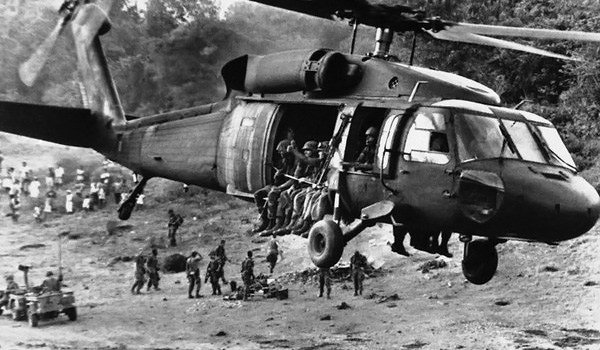
The US Army had intelligence reports stating that the bulk of the PRA force was amassing at Calivigny barracks, 5 kilometres from Point Salines Airfield. An Air Assault was organised, to be carried out by the 2nd Bn, 75th Rangers using the new UH-60 Blackhawk Helicopters.
A preparatory bombardment was to clear the barracks defences. Howitzers, A-7 Corsairs, AC130s and the USS Charon all fired munitions into the barracks and surrounding area.
During the assault, the pilots of the Blackhawks, who had not used them in combat, misjudged their approach and came in too fast.
One Blackhawk crash-landed, causing the 2 Blackhawks behind to collide with it, killing 3 and wounding 4.
The Rangers, after securing the wreckage and evacuating the wounded, pushed onto the barracks. They would find it deserted.
AFTERMATH
Over the following days, resistance ended entirely. Army and Marine forces spread across the island. They captured PRA officials, weapons caches and repatriating Cuban Nationals. On the 1st of November, 2 companies of the 22nd MAU landed on the island of Carriacou. 19 Grenadian defenders surrendered immediately. This marked the end of combat operations in Urgent Fury.
Nearly 8000 US soldiers, airmen, sailors and Marines took part in Urgent Fury. American forces suffered 19 KIA and 116 wounded. Cuba suffered 25 KIA, 59 WIA and 638 captured soldiers. Grenada suffered 45 KIA and 358 WIA, with no concrete number of POWs. At least 24 civilians died.
The US also destroyed the majority of Grenadas military might - 6 APCs and 1 armoured car. A second was impounded and sent to Quantico.
The US forces suffered the loss of 9 helicopters, 3 of which were the new Blackhawk.
Worldwide, reactions to the invasion of Grenada were not as supportive as the US expected. The United Nations General Assembly stated
Quote[the General Assembly] deeply deplores the armed intervention in Grenada, which constitutes a flagrant violation of international law and of the independence, sovereignty and territorial integrity of that State ... [and called for] immediate cessation of the armed intervention
The Soviet Union claimed that Grenada had been threatened repeatedly by the United States and warned that other nations may find themselves at the mercy of US foreign policy.
Following the end of Operation Urgent Fury, Paul Scoon was reaffirmed as governor. He led Grenada to public elections, held in December 1984.
US forces remained on the island in a peacekeeping capacity, as part of Operation Island Breeze. Eventually, all US forces would withdraw.
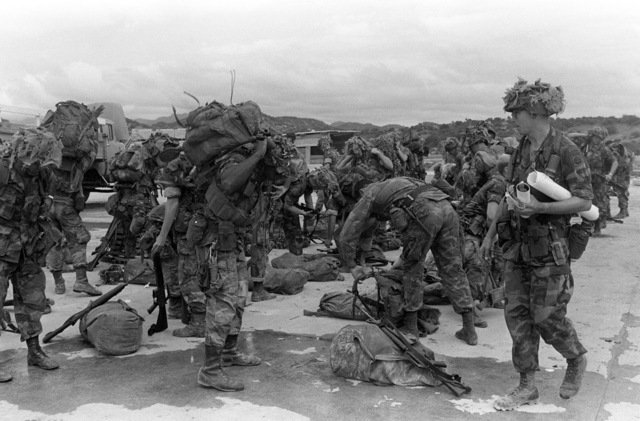
PUTTING IT INTO PRACTICE
Urgent Fury provides a host of different scenarios and strategies that Zeuses can play around with. Due to the limitations of our modpack there's some tinkering and substitutions that have to be made for missions to work. You could easily stage scenarios around the Saint George assault, the Governor's Mansion or the assaults on the Forts. But for a general mission plan, I'll focus on D-Day - the attack on Point Salines International Airport.
For the map, you could use either Tanoa or Tembelan - it needs to be an airfield with a populated area nearby. The northern Airfield of Tembelan is one option, whereas Tanoa International is another. For this scenario I will provide images of Tanoa International.
Having your players paradrop onto a hostile airfield is a challenge of itself, and should provide some interesting gameplay, however if you want to really shake things up; go for the Rangers original plan.
Have C-130Js make an approach on the airfield and have them land, fully laden with players in the back. As the players disembark they should be in an instant firefight with infantry - I'd stay away from having ZUs or any vehicles. One or 2 DShKs on the perimeter could work, but you don't want immediate lines of sight to the planes.
Once the players have captured the Airfield, you could give them objectives in the nearby settlements - simple secure objectives. Take inspiration from the 3 BTRs that attempted a counter-attack - throw in some infantry support and it should make for an interesting challenge.
I'd use OPFOR African Militia as the Grenadian/Cuban forces. They are somewhat un-armoured, so restricting your players load-outs for balance would be advantageous. I recommend some lightweight armour, or for added challenge, use ALICE webbing which provides no armour rating at all. Restrict your players to M16s and M249s. Use M72 LAWs with perhaps 1 M3 MAAWS.
FURTHER READING
If you enjoyed this article and wish to explore Urgent Fury further, there's some official documents I recommend reading.
-
 2
2
-
 10
10


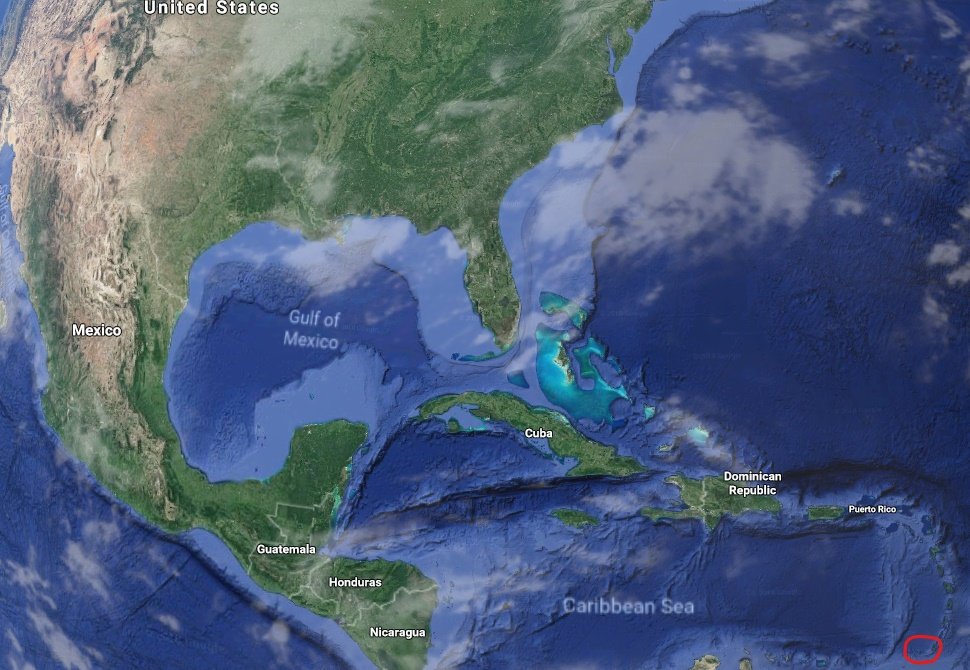
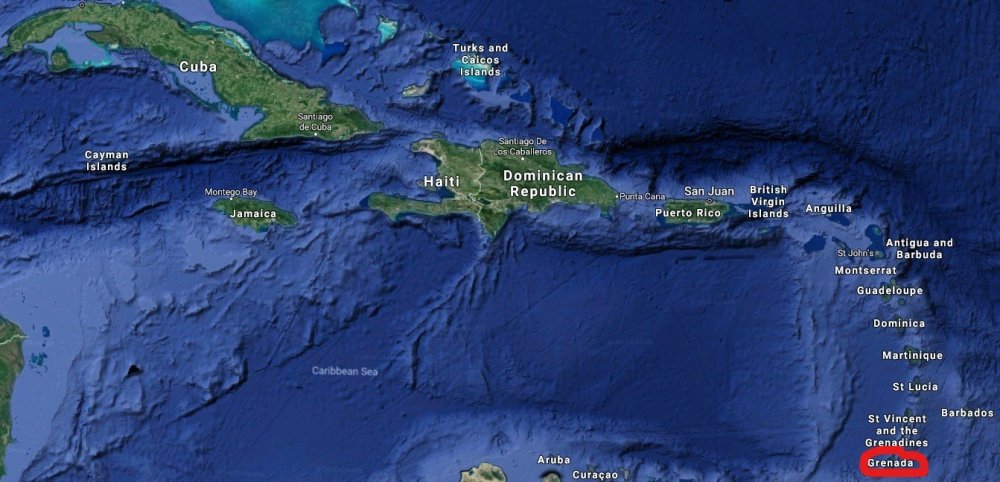
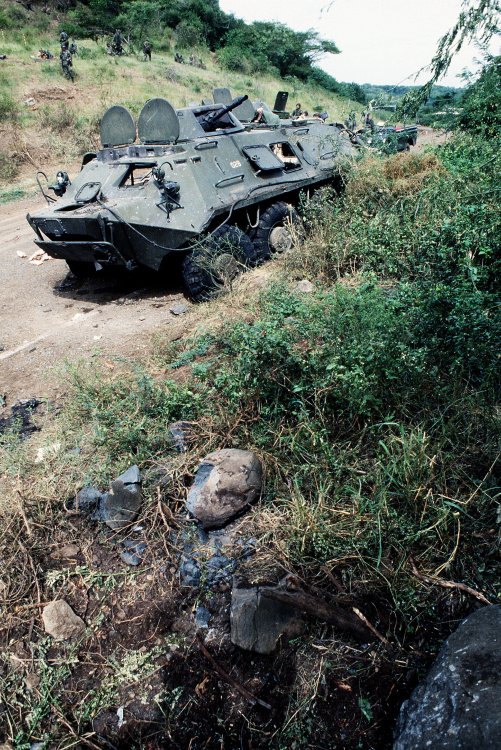
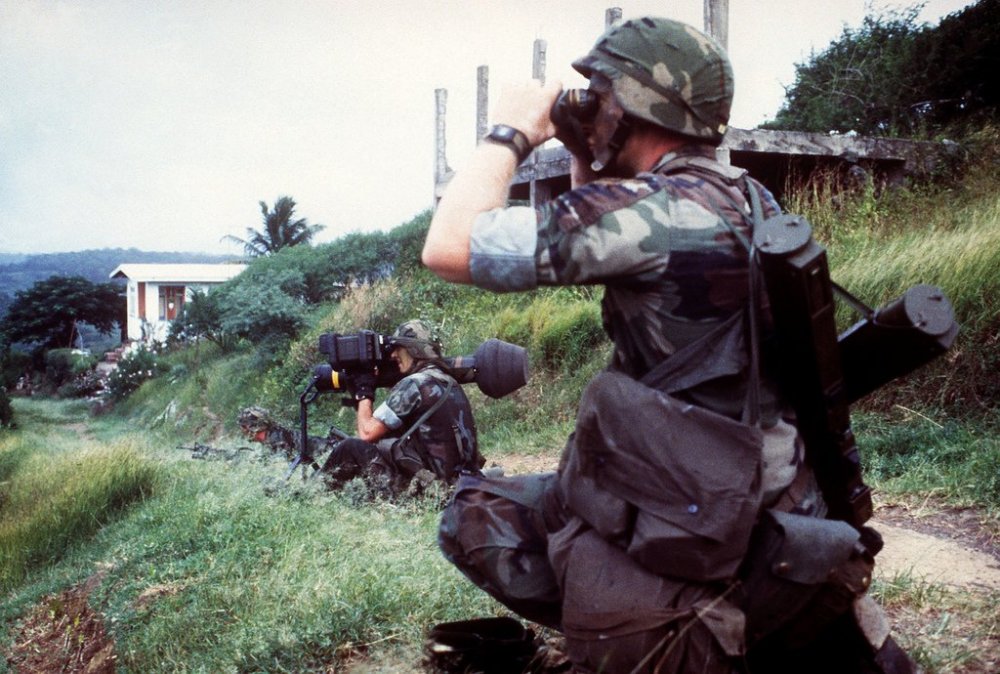
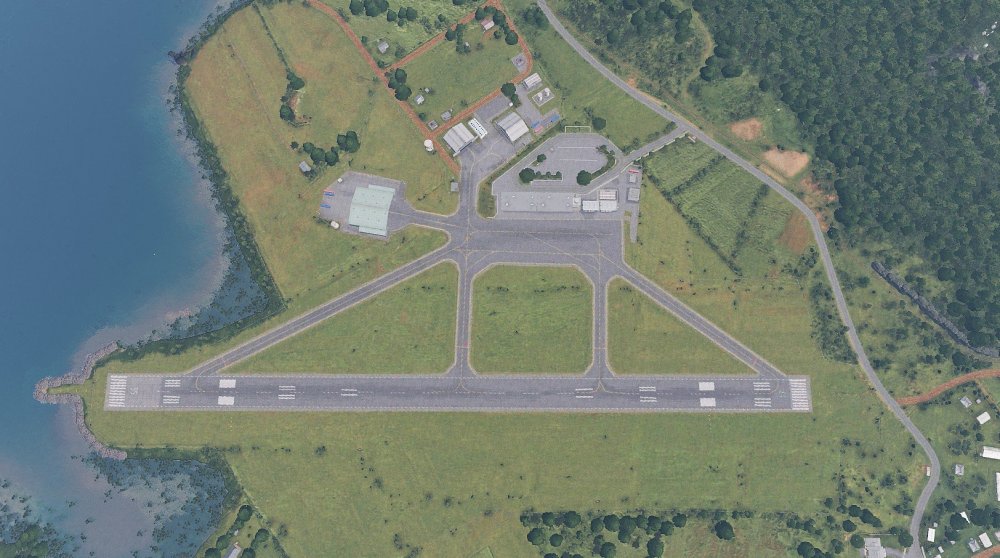
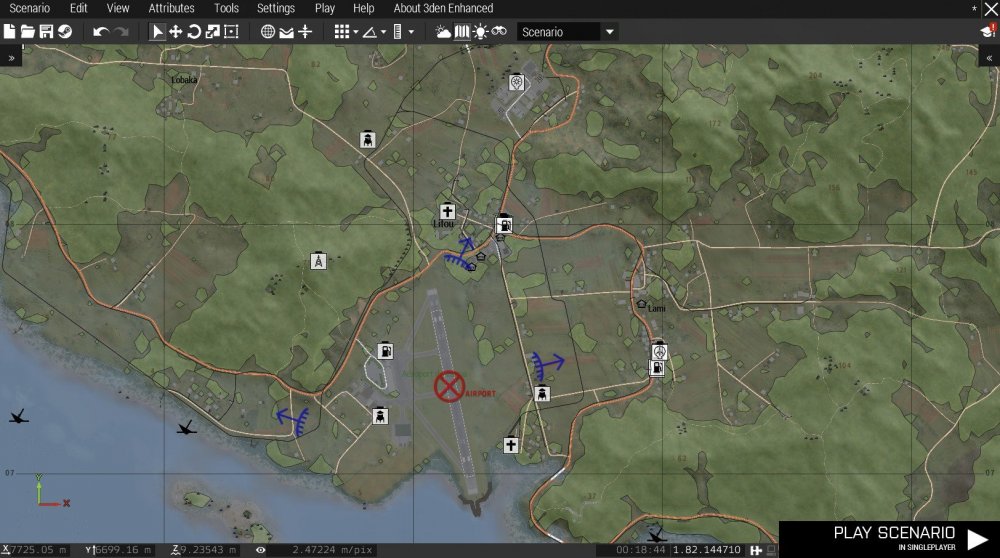
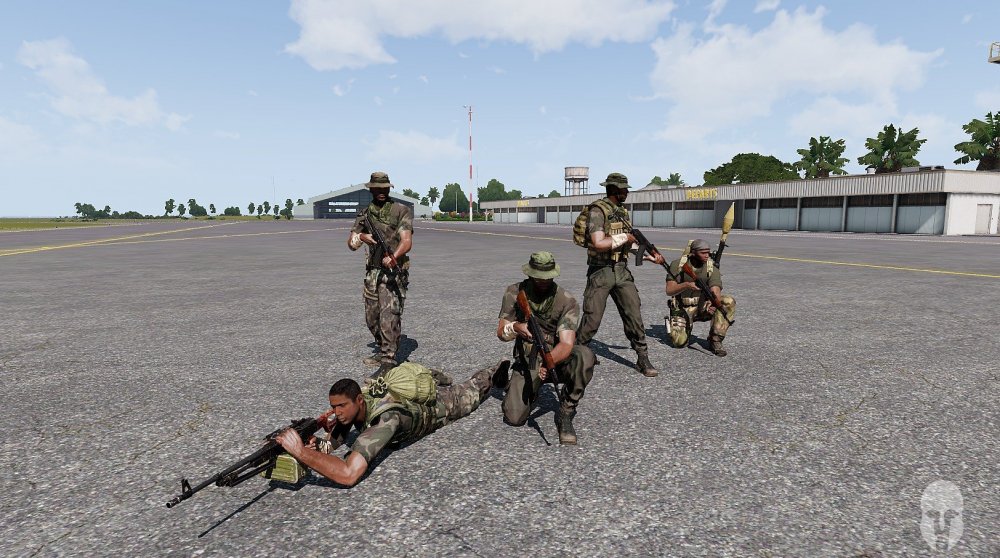



Recommended Comments
Join the conversation
You can post now and register later. If you have an account, sign in now to post with your account.
Note: Your post will require moderator approval before it will be visible.